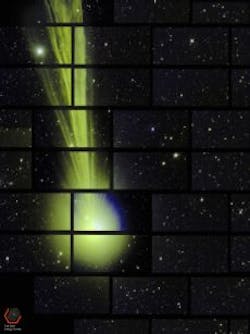World’s most powerful camera captures image of Comet Lovejoy by accident
Developed at the US Department of Energy's Fermi National Accelerator Laboratory in Batavia, Illinois, the Dark Energy Camera holds the title,for now, of being the world’s most powerful camera. While recently photographing the southern sky to study the nature of dark energy, the 570 MPixel camera captured a stunning image of Comet Lovejoy.
MORE ARTICLES
Image sensors designed by e2v aid in detailed study of comet
Sharpest image yet of dwarf planet Ceres captured by NASA spacecraft
Each of the panels in the image (full-size here) shown here was captured by one of the camera’s 62 separate CCD image sensors, during an exposure on December 27, 2014. Each of the 62 CCD sensors has a 2048 x 4096 pixel focal plane array. In addition to these sensors, there are four 2048 x 2048 guider CCDs and eight 2048 x 2048 focus and alignment CCDs. The quantum efficiency of the CCDs—which were designed at Lawrence Berkeley National Laboratory (LNBL)—with their anti-reflective coating, is red optimized to be > 90% at 900nm and over 60% over the range of 400-1000nm. The camera operates at -148°F in order to minimize noise and dark current with the cooling provided by liquid nitrogen. The Dark Energy Survey CCDs were fabricated by Dalsa (Teledyne DALSA), with further processing done by the LBNL.
The camera is sensitive to light from up to 8 billion light years away, and the image of Comet Lovejoy was captured while traveling just 51 million miles from Earth.
Researcher Brian Nordtold Gizmodo that the image of the comet was actually a mistake.
"This was an accidental catch, because Dark Energy Camera scans the sky methodically over a very large region of the sky. Comet Lovejoy only takes up a very small part of the sky, and we didn't intend to point at it, but the camera happened to scanning that part of the sky at that time."
In addition, a blog posted on Dark Energy Detectives, notes that this project "reminds us that before we can look out beyond our Galaxy to the far reaches of the Universe, we need to watch out for celestial objections that are much closer to home!"
View theblog post.
Share your vision-related news by contactingJames Carroll, Senior Web Editor, Vision Systems Design
To receive news like this in your inbox,click here.
Join ourLinkedIn group | Like us on Facebook | Follow us on Twitter| Check us out on Google +
About the Author

James Carroll
Former VSD Editor James Carroll joined the team 2013. Carroll covered machine vision and imaging from numerous angles, including application stories, industry news, market updates, and new products. In addition to writing and editing articles, Carroll managed the Innovators Awards program and webcasts.
